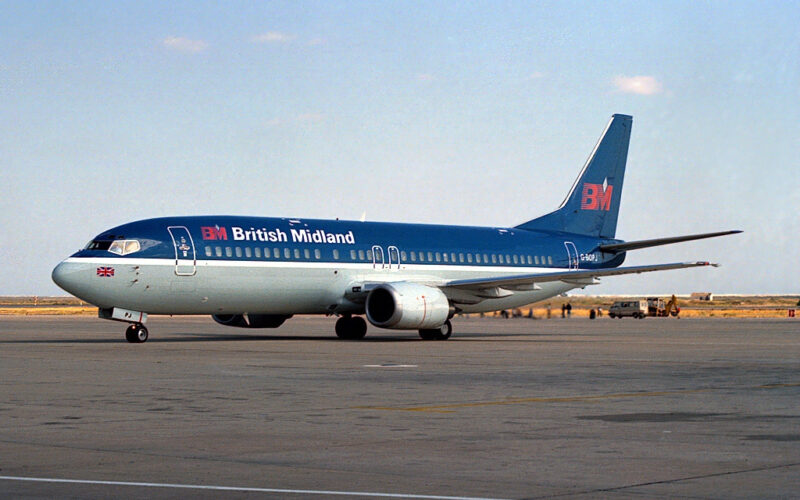January 2024 marks 35 years to the month of the British Midland Airways Kegworth air disaster in Leicestershire, England. The accident involving an almost brand-new Boeing 737 highlighted various practices that changed the way we travel by air today.
Background
On January 8, 1989, British Midland Flight 92 was a scheduled passenger service flying from London-Heathrow Airport (LHR) to Belfast International Airport (BFS) in Northern Ireland. The flight was operated by a Boeing 737-400 that had only been delivered factory-fresh to the airline in October 1988 – less than three months earlier.
The United Kingdom (UK), as well as the rest of the world, was still in shock following the loss of Pan Am Flight 103 over Lockerbie, Scotland just three weeks previously. No one would have expected to see another fatal accident involving a passenger airliner in the UK in such quick succession.
The aircraft involved, registered G-OBME, had undertaken its first flight on October 6, 1988, from the Boeing final assembly facility located in Renton, Washington. The plane was the first of eight 737-400s to be acquired by British Midland and was equipped with a pair of CFM International CFM56 turbofan engines.
Delivered to the airline just nine days after its first flight, the aircraft was configured in an all-economy layout featuring 156 seats and had been operating for British Midland for just 12 weeks at the time of the crash. The aircraft was destroyed in the accident that befell Flight 92 and was subsequently written off. At the time of the accident, the airframe had accumulated just 521 flying hours in total.
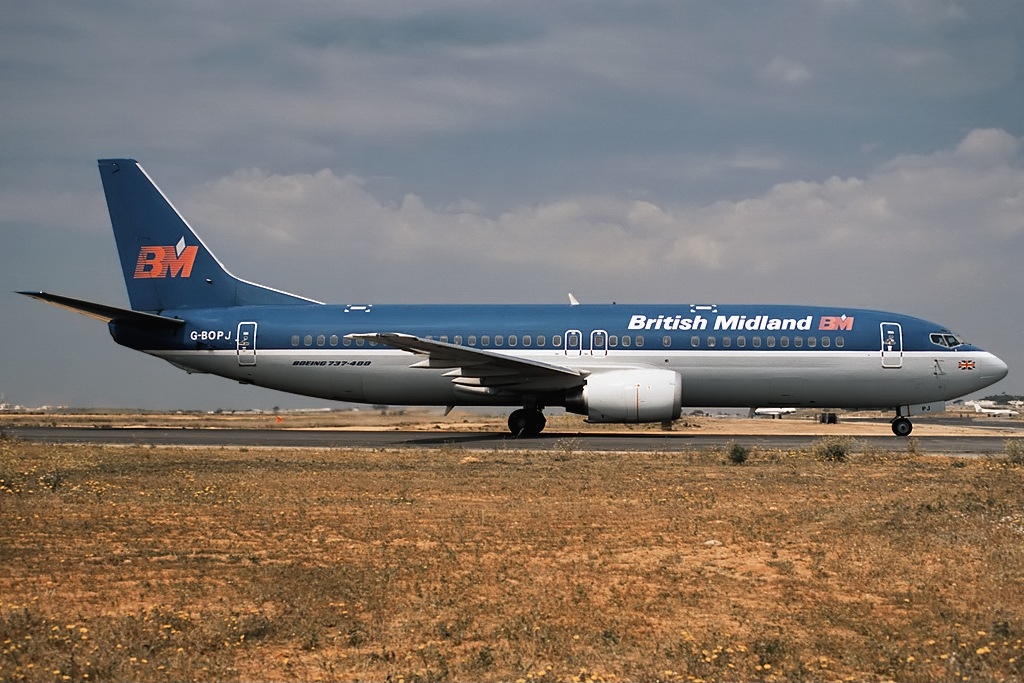
The crew of Flight 92 had a combined total of around 16,500 flight hours, including approximately 1,000 in the 737. The aircraft itself had already made one uneventful round-trip flight between London and Belfast earlier that day. The flight had 118 passengers and eight crew members onboard – two pilots and six cabin crew.
Flight 92 departed Heathrow at 19:52 local time for its hour-long flight to Belfast. The aircraft was in the process of climbing to its intended cruising altitude of 35,000 feet when passing through 28,000 feet, the outer panel of one of the fan blades in the plane’s left hand (number 1) engine detached.
This event caused significant vibration throughout the airframe and a sudden “audible pounding noise” in the passenger cabin. Those seated towards the rear of the cabin also reported seeing sparks and smoke emanating from the failed, left-hand engine and a burning smell. Shortly afterward, smoke began entering the cabin via the aircraft’s air conditioning vents.
However, upon misreading the engine instruments in the flight deck, the pilots believed that it was the right-hand (number 2) engine that had been damaged, and subsequently throttled it back to reduce the vibrations.
Upon the engine failure and following immediate emergency actions, the flight crew radioed the company’s operations department for further advice. It was agreed that Flight 92 should make an emergency diversion to East Midlands Airport (EMA) in Leicestershire. The airport not only happened to be close to the company’s headquarters but also the site of its primary UK maintenance base. Conveniently, the airport was almost directly under the aircraft’s flight path to Belfast that evening.

Flight 92 was cleared for an approach to runway 27 at East Midlands. However, having commenced its descent into East Midlands and with the aircraft’s airspeed decaying, the Ground Proximity Warning Syste m (GPWS) in the flight deck issued several aural ‘glideslope’ warnings, indicating that the plane had deviated below the glideslope for runway 27.
At just 900 feet, 2.4nm from the runway threshold, the (already damaged) left-hand engine suddenly suffered a decrease in power. As the airspeed fell below 125 knots, the stick shaker activated indicating to the pilots the imminent onset of a stall.
Impact and aftermath
At 20:24 and traveling at 115 knots, the aircraft’s rear fuselage, tail, and landing gear struck trees on the eastern bank of the M1 motorway – one of the busiest in the UK. The plane then bounced back into the air and impacted the rising ground on the western embankment of the motorway. The aircraft immediately broke into three sections on impact, having landed almost 2,950ft (900 meters) short of the runway.
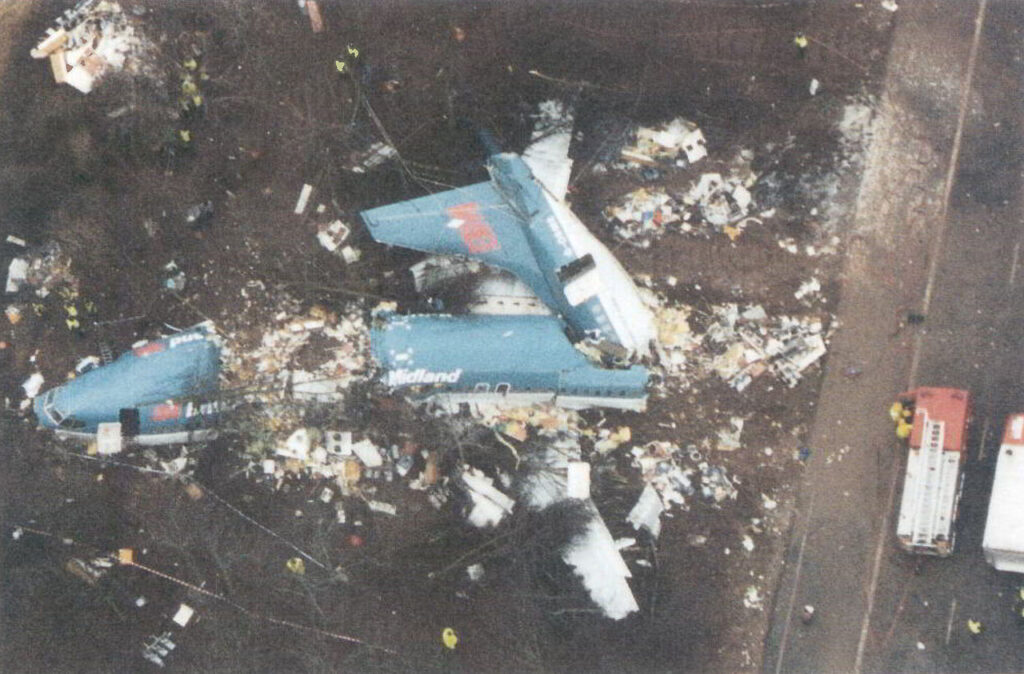
With such violent horizontal forces acting upon the passenger cabin in the impact, 39 passengers died instantly, while a further eight succumbed to their injuries following the crash landing. Fortuitously, there were no injuries or fatalities to anyone driving on the motorway at the time of the crash. Indeed, the proximity of the motorway provided excellent access for the emergency services that quickly arrived at the scene.
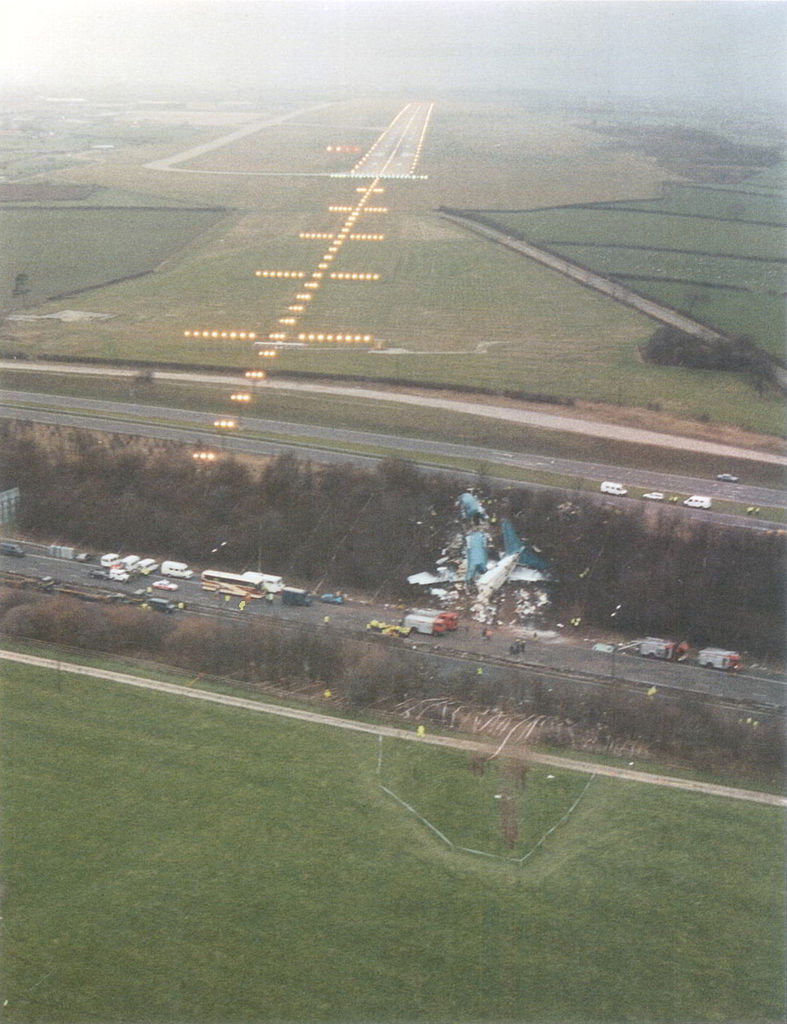
In addition to the 47 immediate fatalities in the crash, 74 of the remaining 79 passengers and crew suffered serious injuries. Both pilots survived, although the first officer suffered life-changing injuries. The crash became one of the UK’s deadliest air disasters and remains the UK’s last fatal accident involving a UK-registered passenger airliner.
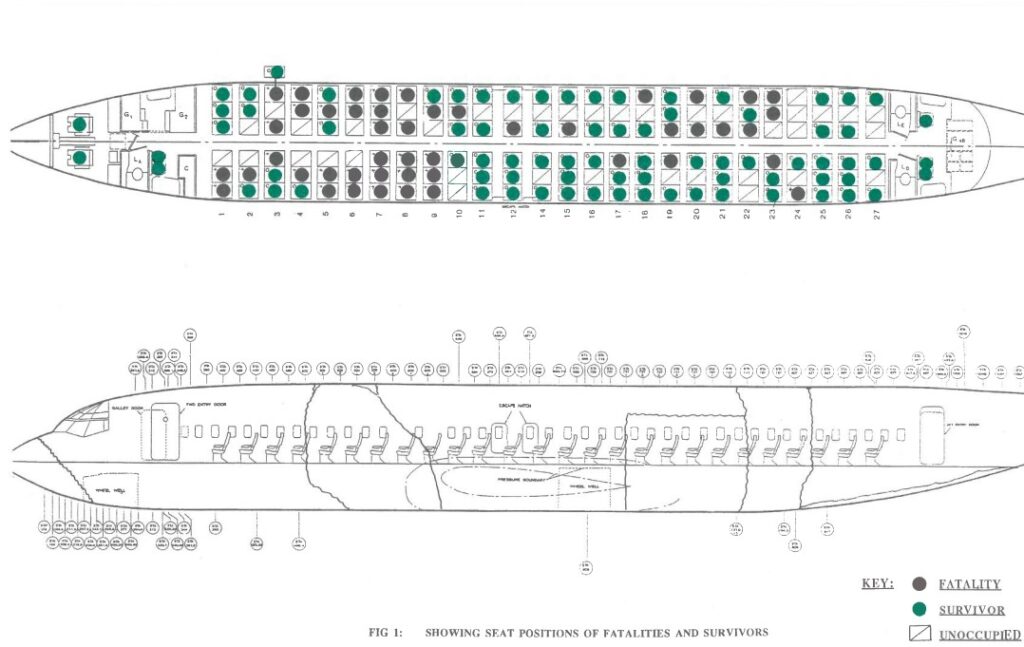
Investigation and findings
The accident report concerning Flight 92 was published by the UK’s Air Accident Investigation Branch in August 1990. The investigation and subsequent report attributed the cause of the accident to pilot error.
The AAIB investigators discovered that despite the failure of the left-hand engine, the crew had throttled back and then subsequently shut down the serviceable right-hand engine. Having reduced the airframe vibrations by taking this action, the pilots believed they had dealt with the engine issue appropriately. However, they had inexplicably shut down the one serviceable engine and were erroneously relying on the failed left-hand engine to get them safely to East Midlands.
It transpired that the right-hand engine in previous 737 variants flown by both pilots supplied the air used for the passenger cabin’s air conditioning system. Given the reports of smoke in the cabin from cabin crew members, the pilots decided to shut down the engine that they believed corresponded to this airflow.
However, unknown to the pilots was that Boeing had redesigned the air conditioning system on the 737-400 to use bleed air from both engines for the air conditioning. Exacerbating the issue was that although passengers had seen sparks and smoke from the left-hand engine, this vital information was never relayed to the pilots.
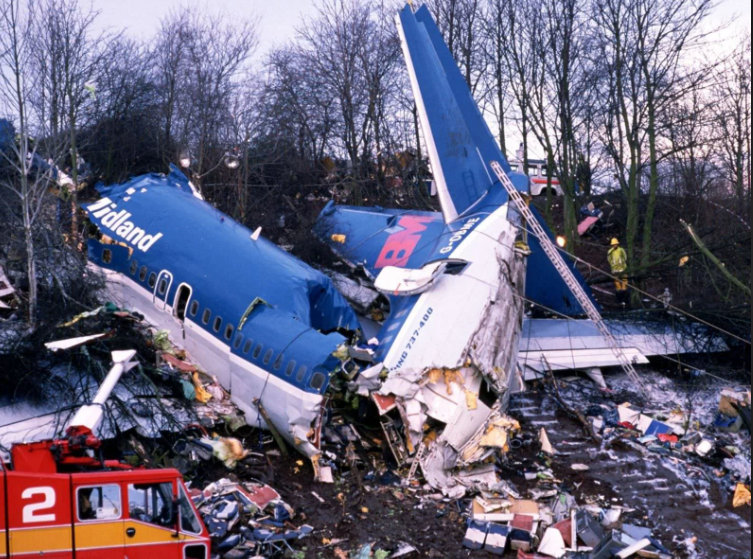
According to the AAIB report, the crew had “reacted to the initial engine problem prematurely and in a way that was contrary to their training.” Additionally, the pilots also failed to “assimilate the indications on the engine instrument display before shutting down the healthy engine.”
The report also stated that when the first officer was asked by the captain which engine was causing the trouble, he responded: “It’s the le … it’s the right one.” The captain responded by saying “OK, throttle it back.”
While many of those on board Flight 92, including three members of the cabin crew, had witnessed flames from the left-hand engine, no one had informed the pilots. This was despite the captain making a cabin announcement explaining (albeit erroneously) that the fault lay with the right-hand engine. The AAIB report called this “extremely unfortunate”.
Remarkably, the damaged left-hand engine continued to provide limited thrust until the aircraft was just under three miles from the runway threshold. But as the pilots called for an increase in power from the damaged engine on short finals, it also failed, leaving no time to try to restart the right-hand serviceable (but shut down) engine.
With the aircraft struggling to fly on just one damaged engine at this critical phase of flight, the left-hand engine was now unable to supply sufficient forward thrust to sustain flight and the aircraft stalled, leading to the impact with the motorway embankment.
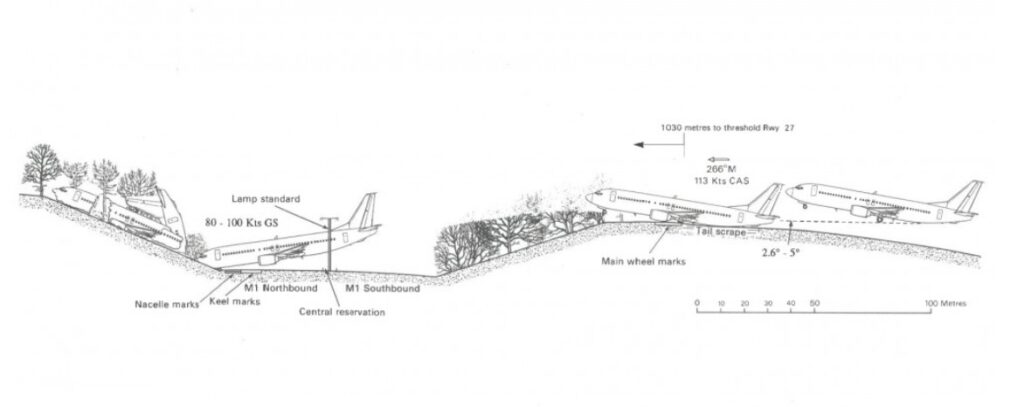
Improvements implemented following Flight 92
The accident involving British Midland Flight 92 led to several recommendations for both operators of the 737-400 and the wider global airline industry.
Almost immediately following the accident, Boeing issued amendments to the 737-400 operations manual issued to all pilots qualified on the type. These changes related to the aircraft’s air conditioning system as well as emergency procedures when diagnosing a possible engine failure.
Other recommendations also focused on pilot training with more emphasis on better coordination between cabin crew and those in the flight deck. The AAIB report also recommended improvements to the standard “brace” emergency position to be assumed by passengers, as well as the need to highlight the brace position diagrams on the emergency cards provided to each passenger and during the passenger safety briefing.
Additional recommendations made by the AAIB included the need for more frequent engine inspections, and more robust overhead stowage bins, as many of these had become dislodged during the impact causing severe head trauma among many of the fatally injured passengers.
Lastly, the report called for air traffic controllers and pilots to always use a separate radio frequency when dealing with an aircraft emergency.
One recommendation which has not led to change was for “aft-facing passenger seats”. Although this had once been a common feature on early passenger aircraft, the concept has not been widely revived following the accident involving Flight 92 as many might have hoped.

